Penang, Malaysia, is known around the world for its street food, and Char Kway Teow is one of its most iconic dishes. Stir-fried with shrimp, Chinese sausage, and flat rice noodles, it’s a bold, savory favorite you’ll find on every must-eat list.

I feel so lucky to call Penang, Malaysia, home. It’s basically heaven for a food lover.
This little island has been recognized time and time again as one of the top places in the world for street food, and Char Kway Teow (or Char Koay Teow) is always at the top of the must-try list.

You’ll find different versions of Char Kway Teow across Southeast Asia, but people from all over still travel to Penang for the real deal.
Besides fresh ingredients, two things really make this dish stand out: super high heat and a well-seasoned wok. Together, they give the noodles that unmistakable wok hei — the smoky “breath of the wok" that adds so much depth and flavor.
I used to make this dish quite a bit when I was living in the United States and missing home. It became one of my go-to ways of bringing a little taste of Penang into my kitchen.
Whether you’ve tasted it on the streets of Penang or you’re just discovering it for the first time, I hope this will inspire you to try making Char Kway Teow at home.
Tools You'll Need
You don’t need an intense, high-heat setup like they use at hawker stalls. Just a good wok and a strong home stove will do the trick. The right tools help you achieve a signature stir-fry flavor without needing commercial firepower.
Whether you're cooking on a gas, electric, or induction stove, make sure to use your hottest burner when you add the noodles to your wok. High heat is key to bringing out the best in this dish.
Wok: A carbon steel or cast iron wok is ideal. Non-stick woks just can’t handle the heat. If you’re using a new wok, check out my step-by-step guide to seasoning it before you start.
Spatula: A metal wok spatula with a flat edge works best for scooping and flipping the noodles in the wok.
Penang Char Kway Teow Ingredients
Here’s what you’ll need to make Char Kway Teow at home. It helps to prep everything first, because once you start cooking, everything moves quickly!

From left to right, top to bottom:
Flat rice noodles – Fresh flat rice noodles are best, but you can use dried flat rice stick noodles if that’s what you have access to. Just soak them in warm water until they’re tender, then drain and toss with a little oil to keep them from sticking.
Egg – I use duck egg when I can get it for the richer flavor, but regular chicken egg works just fine too.
Chinese sausage (lap cheong) – Adds a slightly sweet, savory flavor. Slice it thinly so it cooks quickly.
Sauce mixture – A simple combo of light soy sauce, dark soy sauce, and oyster sauce.
Garlic – Minced fresh garlic is a must for that savory base.
Chili paste – This is called chili boh here in Malaysia. It's a combination of dried and fresh red chili, a bit of garlic and shallot. If you'd like to make it yourself, click here to watch a video by Nyonya Cooking. Otherwise, use a chili paste that you have access to in your area.
Bean sprouts – Rinse and drain them well. Adds crunch and freshness.
Garlic chives – Also called Chinese chives. Cut into roughly 1-inch pieces. If you can’t find these, scallions work in a pinch
Shrimp – Use peeled and deveined shrimp. I like to leave the tails on for looks, but that’s totally optional.
Blood cockles (optional) – Not always easy to find outside Southeast Asia, but they’re a signature ingredient in Penang’s version of CKT. If using, blanch them briefly in boiling water, remove the shells, and add them in with the bean sprouts and chives.

Lard (optional) – Most street vendors in Penang use lard to stir-fry the noodles. You can use neutral oil instead, but lard adds a deeper, more traditional flavor. To make your own lard, cut the pork fat into small cubes and slowly render it over low heat until it is golden and crisp.

Optional: I also like to line the serving plate with banana leaf for the aroma and presentation.
Would you like to save this?
How to Make Penang Char Kway Teow
Before turning on the heat on your stovetop, ensure all your ingredients are prepped and within easy reach. This dish comes together fast, and once you start cooking, there’s no time to stop and chop.
Heat up your wok over medium-high heat. As soon as you see a bit of smoke, pour in about 3 tablespoons of cooking oil or lard. Immediately add 3 - 4 minced garlic cloves and give it a quick stir.

Once the garlic starts to brown at the edges, toss in 4 - 5 large shrimp (peeled and deveined, tail on), 7 - 10 slices of Chinese sausage, and 1 tablespoon of chili boh or chili paste.
Stir-fry just until the shrimp are cooked through. This should only take about a minute. Any longer and the shrimp will overcook. Scoop everything out and set it aside.

If the wok is too dry, give it a splash of oil. Turn up the heat to maximum!
Add the noodles to the wok (approximately 200g of fresh noodles, or 100oz of dried noodles, soaked till tender), followed by the sauce mixture (2 tablespoons Light Soy Sauce + ½ a teaspoon of Dark Soy Sauce
+ ½ a teaspoon of Oyster Sauce). Stir well to make sure the noodles are evenly coated
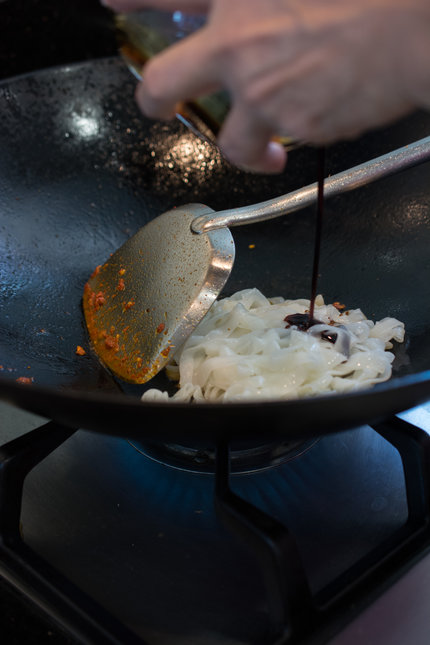
Push the noodles to one side of the wok and crack in 1 egg (preferably duck egg). Let it cook undisturbed for 10 to 20 seconds, then stir it into the noodles.
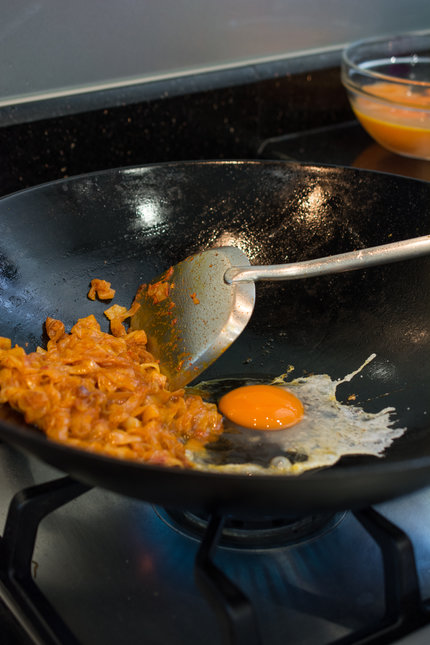
Add 1 cup of fresh bean sprouts and a small handful of garlic chives (cut into 1-inch pieces), along with the cooked shrimp and sausage. Give everything a final toss to combine, then it’s ready to serve.

Line a plate with banana leaf if you have it, pile on the noodles, and top with a few slices of fresh red chili for garnish.
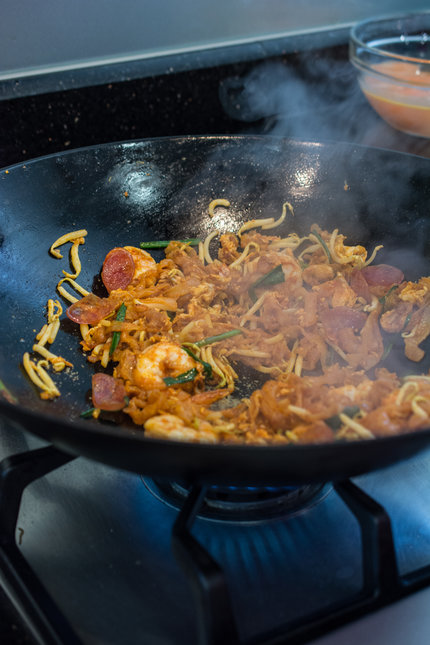
💡 Pro Tips for the Best Char Kway Teow
Prep everything before you start – The cooking goes fast, and there's no time to pause once the wok is hot. Lay everything out within reach so you're not scrambling mid-stir-fry.
Use your hottest burner – Whether you're on a gas, electric, or induction stove, make sure you're cooking over the highest heat you can manage. That’s key for flavor. Turn up the heat to maximum only once you’ve added the noodles.
Don’t overcrowd the wok – If you're doubling the recipe, cook it in batches. Too many ingredients at once will lower the heat, and you’ll lose the sizzle that gives the noodles that treasured wok hei. Even street vendors cook just one or two plates at a time for this reason.
Toss, don’t stir – Use your spatula to gently scoop and flip the noodles rather than stirring them nonstop. Letting the noodles sit against the hot wok for a few seconds at a time helps build that slight char and deeper flavor.
Don’t overcook the shrimp – They only need about a minute to cook. Take them out early, then add them back in at the end so they stay juicy and tender.
A seasoned wok makes a difference – That wok hei flavor comes from high heat and a well-loved wok. If yours is newer, it’ll still be delicious but it gets better the more you use it.
Frequently Asked Questions
Char Kway Teow is a popular Malaysian street food made with flat rice noodles stir-fried in a savory sauce over high heat with shrimp, Chinese sausage, garlic chives, bean sprouts, and egg.
There are different versions of Char Kway Teow across Malaysia and Singapore, but Penang’s version is drier, bolder, and especially prized for its smoky, charred flavor.
A large skillet or cast-iron pan works in a pinch. It’s harder to toss the noodles since there’s less surface area and no curved sides, but the flavors will still be great. Just cook over high heat and avoid overcrowding.
Yes! Skip the shrimp and Chinese sausage, and use a vegetarian oyster sauce or soy-based substitute. You could add tofu for extra texture and flavor.
Green onions (scallions) are a good substitute. The flavor is a little different, but they’ll still add that fresh pop at the end.
Char Kway Teow is best eaten fresh, but leftovers can be stored in an airtight container in the fridge for up to 2 days.
The best way is in a hot pan or wok over high heat for about a minute. Add a splash of water if needed to loosen it up. That said, it’s hard to recreate the same flavor and texture you get when it’s freshly cooked. Char Kway Teow is really one of those dishes that’s best eaten right after it comes off the wok.
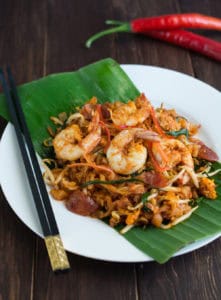
Char Kway Teow
Ingredients
- 3 tablespoons cooking oil or lard
- 3 - 4 cloves garlic minced
- 4 - 5 large shrimp peeled and deveined, tail on
- 7 - 10 slices Chinese sausage
- 1 tablespoon chili boh or chili paste
- 200 g fresh flat rice noodles or 100g dried noodles, soaked
- 2 tablespoons light soy sauce
- ½ teaspoon dark soy sauce
- ½ teaspoon oyster sauce
- 1 egg
- 1 cup fresh bean sprouts washed and drained
- ¼ cup garlic chives cut into 1 inch pieces
- banana leaf optional
- sliced red chili for garnish optional
Instructions
- Make sure you have all ingredients within arms reach. Cooking goes fast!
- Heat up your wok over medium-high heat. As soon as it starts to smoke a little, pour the cooking oil or lard into the wok, immediately followed by the minced garlic. Give it a quick stir.
- When the garlic starts to turn brown at the edges, add shrimp, Chinese sausage, and chili boh or chili paste. Stir-fry until the shrimp are cooked (should only take about a minute), then remove the shrimp and Chinese sausage from the wok. Set aside.
- Turn up the heat to maximum, then add flat rice noodles into the wok. Drizzle the light soy sauce, dark soy sauce and oyster sauce over the noodles. Stir well. Make sure all of the noodles are covered in the sauce.
- Push the noodles to the side of the wok, then crack the egg in the center of the wok. Allow the egg to cook for about 10 - 20 seconds, then stir it in to the noodles.
- Add bean sprouts and garlic chives, followed by the cooked shrimp and Chinese sausage.
- Stir to combine just for a few seconds, then dish it out on to a serving plate lined with a banana leaf. Garnish with sliced fresh red chili.
- Serve immediately. Enjoy!
Notes
Nutrition
Other Malaysian Recipes You May Enjoy



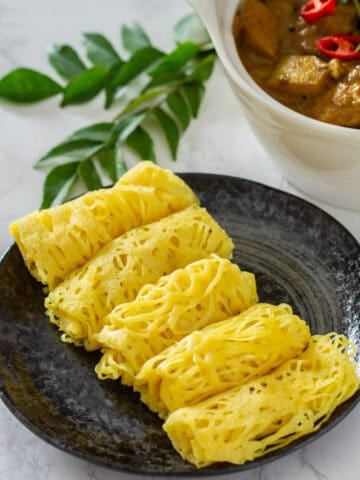
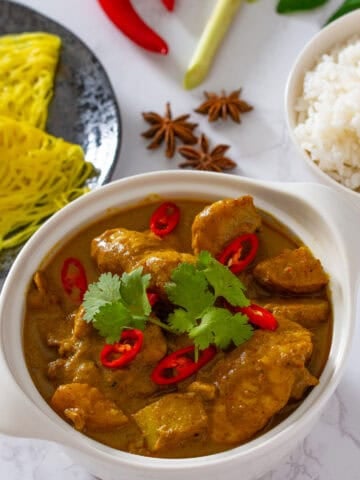

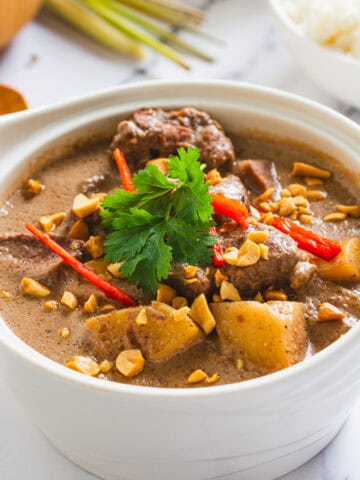
Junior makinjal says
Sounds mouth watering. Will definitely try
Char says
Thank you, Junior! I hope you enjoy the recipe 🙂
Caroline says
Since I cannot eat shellfish or the oyster sauce, etc Char, can it be adapted using chicken or pork with the other ingredients or will that significantly change the flavor profile?
Char says
Hi Caroline! Absolutely! If you can find it, I recommend trying vegetarian oyster flavored sauce. I recommend swapping the shrimp for pork but chicken also works!